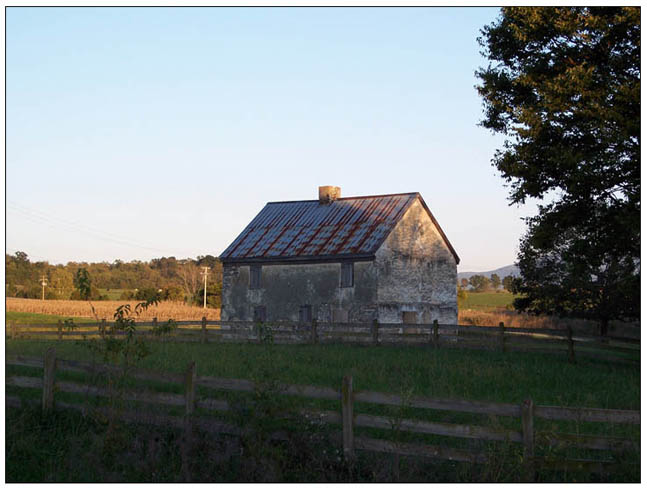
Father: Martin KAUFFMAN
Mother: Barbara STAUFFER
Family 1 : Mary LIONBERGER
Family 2 : Mary TAYLOR
Family 3 : Sarah COFFMAN
__
_Michael KAUFFMAN _|
| |__
_Martin KAUFFMAN _|
| | __
| |_Anna KNEISLEY ____|
| |__
|
|--Martin KAUFFMAN
|
| _Christian STAUFFER____
| _Daniel STAUFFER ____|
| | |_Magdalena BRUBACHER___
|_Barbara STAUFFER__|
| _Ulrich KREHBIEL_____
|_Magdalena KREHBIEL__|
|_Barbara WIDNER______
Notes:
|
Martin Kauffman Jr. (II) is believed to have been the builder of the White House in 1760. He was also known as The Reverend Martin Kauffman and Whitehouse Martin Kauffman. This building still stands between the Shenandoah River and the Lee Highway (211), south west of Luray, Virginia. Originally built as a Mennonite church, the building has also been called a fort because of its significant cellar. Earlier scholars believed that such cellars were constructed in response to the Indian attacks of the 1750's, and a number of other buildings in the valley containing such cellars have also been called forts. Contemporary thought however, suggests another function for the vaulted cellars as a means to have a cool storage area during the hot summer months. |
|
|
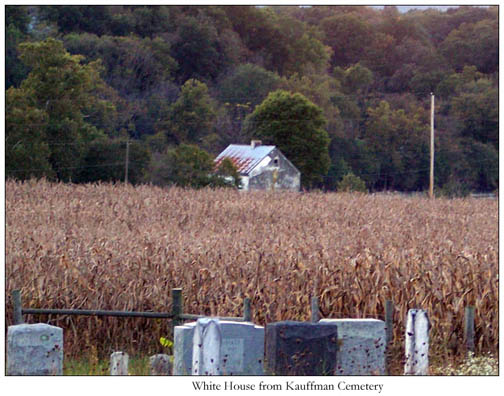
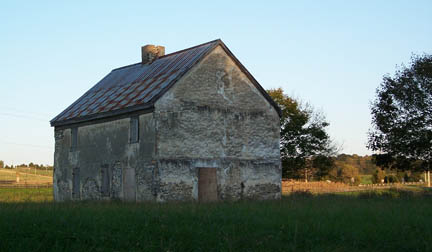 |
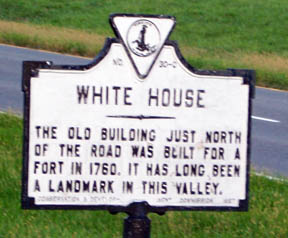 |
|
Martin Kauffman was one the first converts of Elder John Koontz, who came to Shenandoah Valley in 1770 from Faquier County to proselytize a Baptist creed, known as "Old School Baptist" and later as "Primitive Baptist". Bearing several precepts similar and familiar to the Mennonite community of Massanutten, Koontz, through his dynamic style, easily won many converts. Early Baptists meetings were held in Kauffman's White House. As more of the local Mennonite community were converted, the meetings began to be held in Hamburg, at another converted Mennonite church which latter became known as the Mauck Meeting House. Once close colleagues, Koontz and Kauffman split on the issue of bearing arms during the Revolution: Martin followed the earlier precepts of the Mennonites of absolute pacifism, while Koontz, though also a strong believer in pacifism, believed that such matters were up to the individual and should not be a part of church doctrine. The Massanutten community as a whole was split on this issue, with Elder Kauffman returning to conduct Baptist services in his White House, while Elder Koontz continued preaching at his home (the Mauck Meeting House house?). As an issue of confusion, both churches were known as the Mill Creek Baptist Church during this time. |
|
|
|
From the 15 Feb 1800 entry in the Mill Creek Church, Minutes Book: |
|
Motion brought by Bro. D. (?) Mauck wheter (whether) or not ordily (orderly) members from Martin Coffman's Church might join us. The Church agree such may join.
|
|
This may have also been a reference to Martin Kauffman, Jr's son who had left the area for Ohio around this time.
|
|
From the 16 Mar 1811 entry in the Mill Creek Church, Minutes Book: |
|
...on the 15th of June [1811], sister Elisabeth Kaffman (Kauffman) family, one of Martain [sic] Kauffmans members, was rec'd by giving her the right hand of fellowship.
|
|
|
|
From the 18 Apr 1812 entry in the Mill Creek Church, Minutes Book: |
|
Bro. Christian Bumgarner family a member of Martain Coffmans Church joined this Church by giving him the right hand of fellowship.
|
|
Martin Kauffman, Jr was believed to have passed away before this time, and his son was in Ohio.
|
|
|
|
From A History of Shenandoah County Virgina, by John W. Wayland (Shenandoah Publishing House, Strasburg, Virginia: 1927), pp. 207-208: |
|
In early Shenandoah there were at least a few Quakers, as noted elsewhere; and there was a rather large German Quaker (Mennonite) population, especially in the section now Page County. The Mennonite ministers of Shenandoah were an outstanding element in the community's history, particularly in connection with the war of the Revolution. Their stand was taken on strict peace principles. Like others of the same faith in the same section and adjacent sections in the Civil War and the World War, their opposition was probably not directed towards this or that party in the strife, but against war as such. Just before the Revolution the Baptists began to make inroads on the Mennonites through the preaching of John Koontz, James Ireland, and others. The Mennonites became alarmed and sent for preachers from Pennsylvania. As a result, Peter Blosser, Mennonite minister, arrived in Shenandoah from Pennsylvania in 1776, during the opening stages of the war. He was a man of 60, but very active. He led a drive for non-resistance among the German Quakers. This may have been as effective in keeping men out of the army as that of Mulenberg was in making soldiers out of them. Pursuit of Blosser by an officer named Bender illustrates Blosser's fearlessness. Bender swore he would seize and punish Blosser. The latter, to foil him, would hide in immediate proximity to Bender, while Bender's men were scouring the country elsewhere for the non-resistant preacher. Discovery of the ruse threw Bender into rages, but Blosser eluded him. This incident is said to be well known as a reliable fact among Blosser's descendants, though it has perhaps not been put into print more than once. Martin Kauffman, Baptist preacher convert from the Mennonites, did not believe in slavery, oaths, or war. He assisted Blosser in peace propaganda and caused a division in the White House Church. The work of Blosser and his associates explains in large measure why the Shenandoah minute books contain so few names of militia officers appointed during the Revolution from the Mennonite sections of the country. Among early Mennonite preachers of Shenandoah County were Michael Kaufman (1714-1788); John Rhodes, killed by Indians in 1764 or 1766; Jacob Strickler, of "Egypt"; Abraham Heistand, minister in Thornton's Gap after the Revolution; Henry Shank; and Revs. Stauffer and Graybill, who preached in the North Fork (Shenandoah) as early as 1754.
|
|
|
|
From the History and Genealogy of the Bieber, Beaver, Biever, Beeber Family, by the Reverend Irvin M. Beaver (Reading, Pennsylvania; 1939), page 528: |
|
Martin Kaufman II made his will Feb. 25, 1805, with David Beaver and Abraham Strickler as witnesses. He died soon after and at a Court held April 9, 1805, his will was proven by the affirmation of David Beaver and Abraham Strickler, witnesses thereto. (Shenandoah Co. Will Book, folio 324). Later in the year David Beaver migrated to Ohio, settling in what is now Union twp., Licking Co.
|
|
One assumes that this Abraham Strickler is probably a grandson or great grandson of Abraham Strickler, the pioneer, though I have yet been able to place him exactly.
|
|
Splitting again with the community over the issue of slavery, Elder Kauffman's son, Martin Coffman left the Massanutten area sometime in the early 1800's with his collegues and immigrated to Ohio to start another Baptist church. From the History of The Descendants of John Koontz, by Lowell L. Koontz (Alexandria, Virginia: 1979), page 6: |
|
In the year 1805 there was a disagreement in the practice of slavery which resulted in Martin Kaufman, Lewis Seits, and Samuel Comer separating from the Mill Creek Church with a group of followers that moved to Fairfield County, Ohio. The church there was called Pleasant Run and in 1806 the Ohio Association of which Pleasant Run was a member stated the following: "We do not wish to correspond with any association or church that does in principle or practice hold involuntary slavery." Not far from Granville in Ohio is a small place called Luray after Luray, Va. There is also a Luray in Fayette Co., Ohio.
|
|
More details about the history of the White House and Martin Kauffman can be found in a comprehensive web essay, "The Mill Creek Church (Mauck Meeting House) " by Richard Pence. Further information about the Mill Creek Primitive Baptist Church is available on the Church and Family History Research Assistance for Page County, Virginia page of The Primitive Baptist Library of Carthage, Illinois.
Vital data obtained from Freda Saiger and The Family Tree of Michael J. Thissen and the Hart Family websites. Further information about the Kauffman family can also be found and The Descendants of Jacob Kauffman I (a document file from The Brehm/LaPella Family Tree Website) and at The Coffman/Kauffman Family website. |
|
Extracted from material in a 21 July 1906 email from Korbi Roberts, an Irland Family researcher: |
|
The famous Baptist minister Reverend James Ireland preached from the White House in the 1760's. The White House was built in 1760 by Martin Kauffman II and is one of Page County's most well-known landmarks. The White House is frequently mentioned in Civil War writings, especially those concerned with Stonewall Jackson. It is located just off US 211 west of Luray. The White House itself is constructed of stone and is covered with lime and sand mortar on the outside. The kitchen was maintained in a separate building and a covered passageway led from the kitchen to the main house. The vaulted cellar or fort (one of the few remaining today) is reached from the inside of the house through a trap door. Portholes are a typical feature of this construction, through which the settlers might shoot at attackers.
|
|
A copy of a description and history of the White House (including how it looked in 1929) from the 1937 edition of Historic Homes of Northern Virginia was also sent by Korbi Roberts.
|
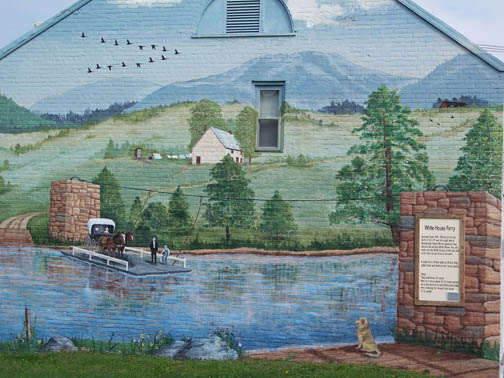
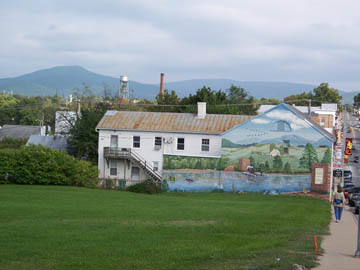
Mural of the "White House Ferry" in Luray, VA. |
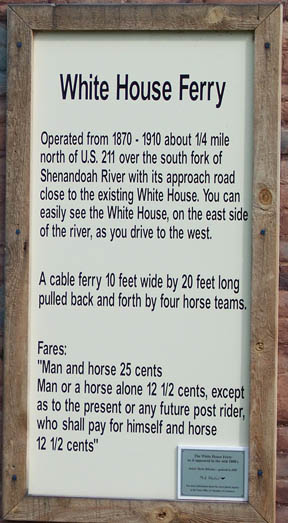 |
|
The area in which the White House stands is also the site of a significant Civil War skirmish. From a Virginia Civil War Trails display in the Kauffman Cemetery on the Lee Highway (211): |
|
WHITE HOUSE BRIDGE Critical Crossing 1862 VALLEY CAMPAIGN On May 21, 1862, Confederate Gen. Thomas "J." "Stonewall" Jackson's Valley Army plodded north along this road to threaten Front Royal and outflank Union Gen. Nathaniel Bank's position at Strasburg. With the addition of Gen. Richard S. Ewell's division, Jackson's command numbered nearly 17,000 men and 50 guns. Philip Kauffman, a young man at the time, remembered the Confederates as they crossed the Shenandoah River on the White House Bridge and: "...Stonewall himself as he ran the gauntlet, with bared head, through the marching columns of his 'foot cavalry.' His faded gray uniform with stars on the collar, his black beard and uncovered head, as he loped by the White House on Old Sorrel, are as fresh in my mind as on that day." Jackson's Valley Army reached Front Royal May 23. There, aided by spy Belle Boyd, it overwhelmed Banks' 1,000-man detachment and continued toward Winchester to attack the main Union army, now in full retreat from Strasburg. Jackson's success was complete. He had defeated and driven Banks from the Valley and alarmed the Lincoln administration. In response to Jackson's bold moved, a two-pronged Federal advance was to converge at Strasburg in an attempt to cut of Jackson's line of withdrawal south. Jackson marched south to escape. Two Federal columns followed in close pursuit -- Gen. John C. Fremont on the Valley Pike and Gen. James Shields in the Page Valley. If Shields could march quickly enough to overtake Jackson's force in the main Valley, he and Fremont could unite and attack with a superior force. To prevent this combination, Jackson ordered his cavalry commander, Turner Ashby, to destroy both the White House and Columbia bridges. Ashby dispatched Capt. Samuel Coyner's Page County Company which rode through "one of the most dreadful thunderstorms" in time to burn the White House Bridge at 4 a.m. on June 2 -- only one hour before Shield's advance guard reached the swollen river. Shields, delayed for three days by the rising river, was forced to abandon his plan to join Fremont at New Market. Jackson defeated Fremont's and Shields' commands separately at Cross Key and Port Republic June 8-9. White House Bridge takes its name from the small building immediately north of the present-day bridge. This early structure was the first home of pioneer Martin Kauffman. For a time it served as a meeting house where, as a minister, Kauffman served a Mennonite congregation.
|
|
|
![]()
This page created on 05/16/2005 21:24:22. Updated 10/12/09 17:42.